The global high performance mercury sorbent market is projected to reach USD 517.8 million by 2035, recording an absolute increase of USD 168.0 million over the forecast period. The market is valued at USD 349.8 million in 2025 and is projected to grow at a CAGR of 4.0% during the forecast period. The overall market size is expected to grow by approximately 1.5 times during the same period, supported by increasing environmental regulations for mercury emissions control, growing industrial awareness of mercury contamination risks, and expanding applications in power generation and industrial manufacturing worldwide. The high material costs and complex application requirements may pose challenges to market expansion.
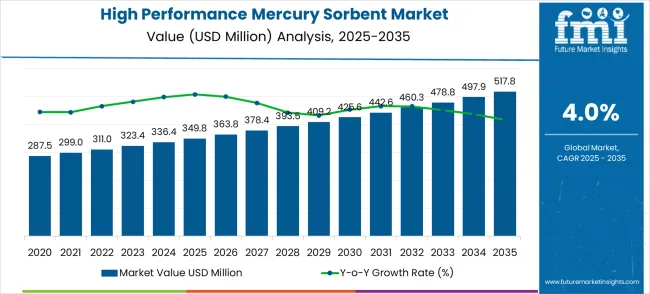
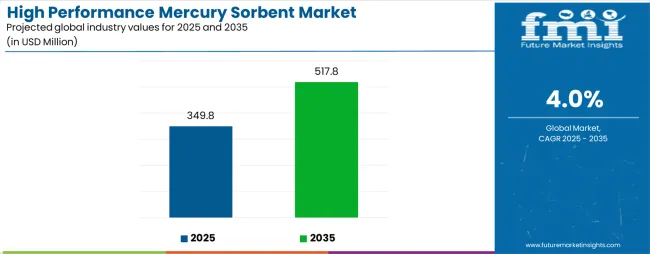
Between 2025 and 2030, the high performance mercury sorbent market is projected to expand from USD 349.8 million to USD 425.6 million, resulting in a value increase of USD 75.8 million, which represents 45.1% of the total forecast growth for the decade. This phase of development will be shaped by rising demand for industrial emissions control solutions, product innovation in advanced sorbent technologies and mercury capture efficiency systems, as well as expanding integration with flue gas treatment systems and environmental monitoring platforms. Companies are establishing competitive positions through investment in advanced material science capabilities, environmental compliance solutions, and strategic market expansion across power generation, industrial manufacturing, and waste treatment applications.
From 2030 to 2035, the market is forecast to grow from USD 425.6 million to USD 517.8 million, adding another USD 92.2 million, which constitutes 54.9% of the overall ten-year expansion. This period is expected to be characterized by the expansion of specialized sorbent systems, including selective mercury capture materials and integrated monitoring solutions tailored for specific industrial applications, strategic collaborations between sorbent providers and environmental technology companies, and an enhanced focus on regulatory compliance and environmentally conscious mercury emission control.
| Metric | Value |
|---|---|
| Market Value (2025) | USD 349.8 million |
| Market Forecast Value (2035) | USD 517.8 million |
| Forecast CAGR (2025-2035) | 4.0% |
The High Performance Mercury Sorbent Market grows by enabling industrial facilities to achieve regulatory compliance and enhanced environmental protection through effective mercury emission control systems. Industrial operators face mounting pressure to reduce mercury emissions and meet stringent environmental standards, with mercury sorbents typically achieving 85-95% mercury removal efficiency compared to conventional emission control methods, making advanced sorbent systems essential for modern industrial environmental compliance infrastructure.
The environmental industry's need for reliable mercury capture and regulatory adherence creates demand for advanced sorbent solutions that can handle various mercury species, provide consistent removal performance, and ensure seamless integration with existing emission control systems without operational disruptions. Government regulations promoting environmental protection and public health safety drive adoption in power generation, cement manufacturing, and industrial processing applications, where reliable mercury emission control has a direct impact on regulatory compliance and environmental stewardship.
Environmental protection initiatives and mercury emission reduction mandates drive adoption across coal-fired power plants, industrial manufacturing facilities, and waste treatment operations. The high sorbent material costs and the complexity of optimizing sorbent performance for specific industrial applications may limit adoption rates among smaller industrial facilities and developing regions with limited environmental compliance infrastructure investment capabilities.
The market is segmented by Material Type, Application, and region. By material type, the market is divided into carbon-based material, metal sulfide, metal oxide, and others. Based on the application, the market is categorized into mercury removal from industrial flue gas, treatment of mercury-containing wastewater, groundwater remediation, medical safety, and others. Regionally, the market is divided into Asia Pacific, Europe, North America, Latin America, and Middle East & Africa.
Carbon-based Material is projected to account for 64.2% share of the High Performance Mercury Sorbent Market in 2025. This dominant position is supported by the material's widespread application in flue gas treatment systems, industrial emission control facilities, and power generation plants, where activated carbon and specialized carbon sorbents provide cost-effective and efficient mercury capture solutions. The segment enables stakeholders to benefit from proven adsorption mechanisms, established application procedures, and enhanced mercury removal efficiency that complies with international environmental standards and emission control regulations.
The widespread adoption of carbon-based systems in coal-fired power plants and industrial manufacturing facilities across major industrial regions worldwide drives consistent demand for these solutions, as operators prioritize proven technologies that maximize mercury removal efficiency while providing reliable performance and regulatory compliance capabilities.
Metal Sulfide systems represent 18.7% of the market share, primarily serving specialized mercury removal applications and chemical treatment processes that require targeted mercury species capture. These materials are essential for mercury-containing wastewater treatment, specialized industrial processes, and facilities where chemical binding mechanisms provide superior performance for specific mercury forms. Metal Oxide solutions account for 12.4% market share, serving high-temperature applications and industrial processes requiring thermal stability and chemical resistance.
The Others category, accounting for 4.7% market share, includes specialized sorbent materials designed for specific applications such as composite sorbents and experimental mercury capture technologies.
Key advantages include:
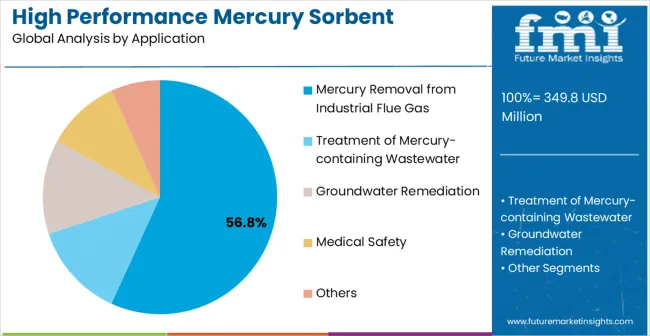
Mercury Removal from Industrial Flue Gas applications are expected to represent 56.8% share of High Performance Mercury Sorbent applications in 2025. This leading position reflects the critical role of sorbent systems in power plant emission control, industrial stack gas treatment, and air pollution control infrastructure, where mercury capture is essential for environmental compliance and public health protection. The segment provides critical support for emission control in coal-fired power generation and industrial manufacturing where consistent mercury removal performance directly impacts regulatory compliance and environmental impact reduction.
Growth drivers include environmental regulation enforcement, increasing demand for clean air technologies, industrial facility modernization requiring advanced emission control systems, and the need for mercury capture solutions that support environmental protection and public health safety goals.
Treatment of Mercury-containing Wastewater applications account for 21.4% of the market share, serving industrial wastewater treatment facilities, chemical processing plants, and mining operations that require effective mercury removal from liquid waste streams. Groundwater Remediation applications represent 12.3% market share, primarily focused on contaminated site cleanup, environmental restoration projects, and subsurface mercury contamination treatment.
Medical Safety applications contribute 6.7% market share, supporting healthcare facilities, dental practices, and medical waste treatment operations where mercury handling and disposal safety are essential for worker protection and environmental compliance. The Others category, representing 2.8% market share, includes specialized applications such as laboratory mercury cleanup and research facility safety systems.
Key market dynamics include:
The market is driven by three concrete demand factors tied to environmental protection outcomes. First, environmental regulations and mercury emission standards create increasing demand for effective mercury control systems, with industrial facilities facing mandatory compliance requirements that typically require 90% or greater mercury removal efficiency, necessitating comprehensive mercury sorbent infrastructure. Second, public health awareness and environmental protection mandates drive adoption of advanced mercury capture technologies, with many countries implementing stringent mercury emission limits and monitoring requirements by 2030.
Third, technological advancements in sorbent materials and mercury capture mechanisms enable more efficient and cost-effective solutions that reduce operational expenses while improving environmental protection standards and regulatory compliance capabilities. The growing emphasis on ecological industrial operations creates additional demand for environmentally responsible sorbent systems that integrate with existing emission control infrastructure and provide comprehensive mercury management solutions.
Market restraints include high material costs that can deter smaller industrial facilities from implementing advanced mercury control systems, particularly in developing regions where funding for environmental compliance equipment remains limited. Technical complexity poses another significant challenge, as optimizing sorbent performance requires specialized expertise and system integration knowledge, potentially causing implementation delays and increased operational costs.
Regulatory compliance variations across different jurisdictions create additional complexity for manufacturers and industrial operators, demanding ongoing adaptation to varying emission standards and monitoring requirements. The challenge of maintaining consistent sorbent performance across different industrial applications presents operational difficulties that may result in extended optimization periods and higher system maintenance costs than initially projected.
Key trends indicate accelerated adoption in Asia-Pacific markets, particularly China and India, where rapid industrial development and environmental regulation enforcement drive comprehensive mercury emission control system deployment. Design shifts toward selective mercury capture materials with enhanced adsorption capacity, improved temperature resistance, and integrated monitoring capabilities enable optimized performance approaches that reduce waste and operational costs.
The increasing focus on mercury speciation control and multi-pollutant capture drives demand for advanced sorbent solutions that can handle various mercury forms while providing comprehensive emission control across industrial networks. The market thesis could face disruption if alternative mercury control technologies or significant changes in environmental regulations minimize reliance on traditional sorbent-based mercury capture systems.
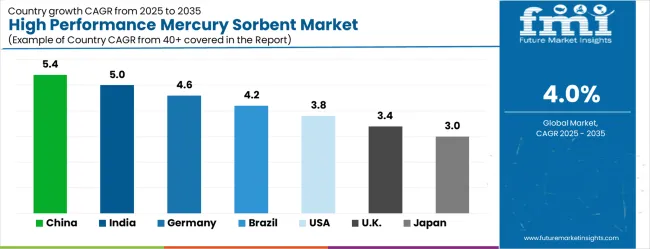
| Country | CAGR (2025-2035) |
|---|---|
| China | 5.4% |
| India | 5.0% |
| Germany | 4.6% |
| Brazil | 4.2% |
| USA | 3.8% |
| UK | 3.4% |
| Japan | 3.0% |
The high performance mercury sorbent market is accelerating worldwide, with China leading at a CAGR of 5.4%, driven by massive industrial emission control expansion and government-backed environmental protection investments. Close behind, India, growing at 5.0% CAGR, is propelled by industrial modernization and environmental compliance initiatives, positioning it as a strategic Asia-Pacific environmental technology hub. Germany advances steadily with a 4.6% CAGR, supported by integration of advanced emission control technologies within Europe's environmental protection infrastructure.
Brazil, expanding at 4.2% CAGR, emphasizes industrial environmental compliance and emission control development. The U.S. records 3.8% CAGR, reflecting continued adoption of environmental technologies, while the U.K. (3.4% CAGR) and Japan (3.0% CAGR) sustain consistent environmental technology modernization. Together, China and India anchor global growth momentum, while others contribute stability and regulatory leadership.
China demonstrates the strongest growth potential in the high performance mercury sorbent market with a CAGR of 5.4% through 2035. The country's leadership position stems from massive coal-fired power plant emission control upgrades, government-backed environmental protection programs, and comprehensive industrial emission reduction mandates driving the adoption of mercury capture systems.
Growth is concentrated in major industrial regions, including Shanxi, Inner Mongolia, Hebei, and Shandong provinces, where power plants and heavy industrial facilities are implementing advanced sorbent solutions for enhanced emission control and environmental compliance. Distribution channels through state-approved environmental equipment suppliers and pollution control technology programs expand deployment across power generation facilities and industrial manufacturing plants.
The country's "Blue Sky Defense War" initiative provides policy support for air pollution control technologies, including advanced mercury emission control system adoption and environmental compliance capabilities development.
Key market factors:
In Delhi, Mumbai, Chennai, and Kolkata, adoption of high performance mercury sorbent systems is accelerating across power generation facilities and industrial manufacturing plants, driven by rapid environmental regulation enforcement and government pollution control initiatives. The market demonstrates strong growth momentum with a CAGR of 5.0% through 2035, linked to comprehensive emission control infrastructure development and increasing focus on air quality improvement capabilities.
Indian industrial operators are implementing advanced sorbent systems and emission monitoring platforms to enhance environmental compliance while meeting growing regulatory requirements in expanding industrial operations. The country's National Clean Air Programme creates sustained demand for mercury emission control solutions, while increasing emphasis on environmental protection drives adoption of advanced emission control equipment.
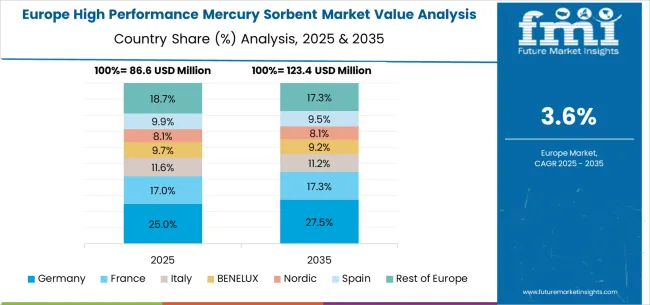
Germany's advanced environmental sector demonstrates sophisticated implementation of high performance mercury sorbent systems, with documented case studies showing significant improvements in emission control efficiency and environmental compliance through precision mercury capture platforms. The market maintains steady growth through focus on environmental technology innovation and regulatory compliance leadership, with a CAGR of 4.6% through 2035. The country's industrial infrastructure in major regions, including North Rhine-Westphalia, Bavaria, and Lower Saxony, showcases integration of advanced sorbent technologies with existing emission control systems, leveraging expertise in environmental engineering and pollution control technologies.
German industrial operators emphasize engineering excellence and environmental standards, creating demand for high-performance sorbent solutions that support continuous environmental improvement and advanced emission control requirements.
Key development areas:
Brazil's market expansion is driven by diverse industrial emission control demand, including power generation facilities in São Paulo and Rio de Janeiro, industrial manufacturing in major urban centers, and comprehensive environmental modernization across multiple states. The country demonstrates promising growth potential with a CAGR of 4.2% through 2035, supported by federal government environmental protection programs and state-level industrial emission control investment initiatives.
Brazilian industrial operators face implementation challenges related to capital investment constraints and technical expertise availability, requiring phased deployment approaches and financing support from international environmental development institutions. The growing environmental regulations and air quality improvement demands create compelling business cases for sorbent adoption, particularly in metropolitan industrial areas where emission control has a direct impact on public health and environmental quality.
Market characteristics:
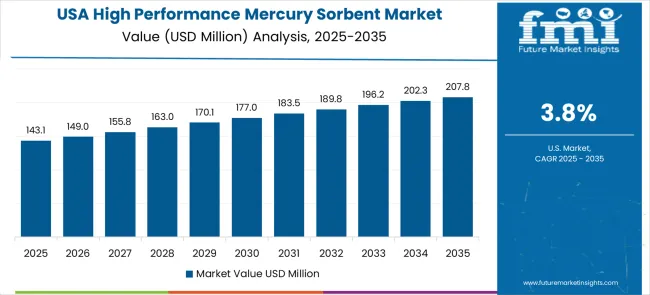
The U.S. market leads in advanced sorbent system innovation based on integration with emission monitoring systems and artificial intelligence technologies for enhanced mercury capture optimization. The country shows strong potential with a CAGR of 3.8% through 2035, driven by the continued enforcement of mercury and air toxics standards and ongoing modernization of power generation and industrial emission control infrastructure.
American industrial facilities are adopting intelligent sorbent systems for operational efficiency improvement and regulatory compliance, particularly in regions with established coal-fired power generation and heavy industrial operations requiring advanced mercury control capabilities. Technology deployment channels through established environmental equipment distributors and direct manufacturer relationships expand coverage across power plants and industrial manufacturing operations.
Leading market segments:
In England, Scotland, Wales, and Northern Ireland, industrial facilities are implementing high performance mercury sorbent solutions to meet environmental regulations and improve emission control efficiency, with documented case studies showing significant improvements in mercury removal performance and regulatory compliance. The market shows moderate growth potential with a CAGR of 3.4% through 2035, linked to the ongoing implementation of environmental regulations and industrial emission control modernization.
British industrial operators are adopting advanced sorbent and monitoring platforms to enhance environmental compliance while maintaining operational efficiency standards demanded by environmental agencies and industrial regulations. The country's established environmental regulatory framework creates sustained demand for proven and upgrade solutions that integrate with existing emission control systems.
Market development factors:
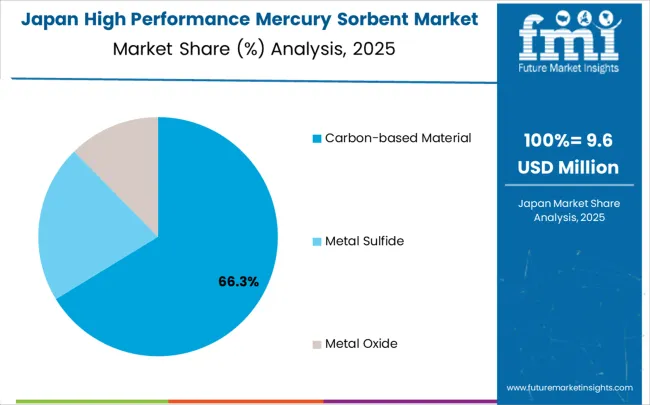
Japan's High Performance Mercury Sorbent Market demonstrates sophisticated implementation focused on precision engineering and environmental excellence optimization, with documented integration of advanced emission control systems achieving significant improvements in mercury removal efficiency and environmental compliance across power generation and industrial manufacturing networks.
The country maintains steady growth momentum with a CAGR of 3.0% through 2035, driven by industrial facilities' emphasis on environmental quality standards and continuous improvement methodologies that align with environmental stewardship principles applied to emission control operations. Major industrial regions, including Kanto, Kansai, and Chubu areas, showcase advanced deployment of intelligent sorbent platforms where mercury control systems integrate seamlessly with existing environmental monitoring systems and comprehensive quality management programs.
Key market characteristics:
The high performance mercury sorbent market features approximately 10-15 meaningful players with moderate concentration, where the top three companies control roughly 45-50% of global market share through established material science platforms and extensive environmental industry relationships. Competition centers on technological innovation, mercury removal efficiency, and environmental compliance expertise rather than price competition alone.
Market leaders include Albemarle Corporation, Johnson Matthey, and BASF, which maintain competitive advantages through comprehensive environmental solution portfolios, global supply networks, and deep expertise in materials science and environmental applications, creating high switching costs for customers. These companies leverage established customer relationships and ongoing technical support contracts to defend market positions while expanding into adjacent environmental technology applications.
Challengers encompass Ecolab and Honeywell, which compete through specialized sorbent solutions and strong presence in industrial and environmental markets. Technology specialists, including CalgonCarbon Corporation, Norit, and NEI, focus on specific sorbent technologies or vertical applications, offering differentiated capabilities in activated carbon systems, specialty materials, and advanced mercury capture mechanisms.
Regional players and emerging technology providers create competitive pressure through cost-effective solutions and specialized application expertise, particularly in high-growth markets including China and India, where local presence provides advantages in customer support and regulatory compliance understanding. Market dynamics favor companies that combine advanced materials science with comprehensive environmental service offerings that address the complete mercury control lifecycle from material supply through ongoing performance optimization.
The high performance mercury sorbent market is central to environmental protection, industrial emission control, and public health safety systems. With environmental regulatory pressures, industrial emission reduction mandates, and rising awareness of mercury health risks, the sector faces pressure to balance capture efficiency, cost effectiveness, and environmental sustainability. Coordinated action from governments, environmental agencies, technology providers, suppliers, and investors is essential to transition toward highly efficient, environmentally ecological, and cost-effective mercury sorbent systems.
| Item | Value |
|---|---|
| Market Value (2025) | USD 349.8 million |
| Material Type | Carbon-based Material, Metal Sulfide, Metal Oxide, Others |
| Application | Mercury Removal from Industrial Flue Gas, Treatment of Mercury-containing Wastewater, Groundwater Remediation, Medical Safety, Others |
| Regions Covered | Asia Pacific, Europe, North America, Latin America, Middle East & Africa |
| Countries Covered | China, India, Germany, Brazil, U.S., U.K., Japan, and 25+ additional countries |
| Key Companies Profiled | Albemarle Corporation, Ecolab, NEI, Honeywell, Johnson Matthey, CalgonCarbon Corporation, Norit, BASF, Lhoist |
| Additional Attributes | Market share analysis by material type and application segments, country-wise CAGR projections across Asia Pacific, Europe, and North America, competitive landscape with environmental technology manufacturers and emission control providers, technology adoption patterns for power generation and industrial emission control, integration with environmental monitoring systems and regulatory compliance platforms, innovations in mercury capture efficiency and sorbent regeneration technologies, and development of specialized solutions with enhanced environmental performance and regulatory compliance capabilities. |
The global high performance mercury sorbent market is estimated to be valued at USD 349.8 million in 2025.
The market size for the high performance mercury sorbent market is projected to reach USD 517.8 million by 2035.
The high performance mercury sorbent market is expected to grow at a 4.0% CAGR between 2025 and 2035.
The key product types in high performance mercury sorbent market are carbon-based material, metal sulfide and metal oxide.
In terms of application, mercury removal from industrial flue gas segment to command 56.8% share in the high performance mercury sorbent market in 2025.






Our Research Products

The "Full Research Suite" delivers actionable market intel, deep dives on markets or technologies, so clients act faster, cut risk, and unlock growth.

The Leaderboard benchmarks and ranks top vendors, classifying them as Established Leaders, Leading Challengers, or Disruptors & Challengers.

Locates where complements amplify value and substitutes erode it, forecasting net impact by horizon

We deliver granular, decision-grade intel: market sizing, 5-year forecasts, pricing, adoption, usage, revenue, and operational KPIs—plus competitor tracking, regulation, and value chains—across 60 countries broadly.

Spot the shifts before they hit your P&L. We track inflection points, adoption curves, pricing moves, and ecosystem plays to show where demand is heading, why it is changing, and what to do next across high-growth markets and disruptive tech

Real-time reads of user behavior. We track shifting priorities, perceptions of today’s and next-gen services, and provider experience, then pace how fast tech moves from trial to adoption, blending buyer, consumer, and channel inputs with social signals (#WhySwitch, #UX).

Partner with our analyst team to build a custom report designed around your business priorities. From analysing market trends to assessing competitors or crafting bespoke datasets, we tailor insights to your needs.
Supplier Intelligence
Discovery & Profiling
Capacity & Footprint
Performance & Risk
Compliance & Governance
Commercial Readiness
Who Supplies Whom
Scorecards & Shortlists
Playbooks & Docs
Category Intelligence
Definition & Scope
Demand & Use Cases
Cost Drivers
Market Structure
Supply Chain Map
Trade & Policy
Operating Norms
Deliverables
Buyer Intelligence
Account Basics
Spend & Scope
Procurement Model
Vendor Requirements
Terms & Policies
Entry Strategy
Pain Points & Triggers
Outputs
Pricing Analysis
Benchmarks
Trends
Should-Cost
Indexation
Landed Cost
Commercial Terms
Deliverables
Brand Analysis
Positioning & Value Prop
Share & Presence
Customer Evidence
Go-to-Market
Digital & Reputation
Compliance & Trust
KPIs & Gaps
Outputs
Full Research Suite comprises of:
Market outlook & trends analysis
Interviews & case studies
Strategic recommendations
Vendor profiles & capabilities analysis
5-year forecasts
8 regions and 60+ country-level data splits
Market segment data splits
12 months of continuous data updates
DELIVERED AS:
PDF EXCEL ONLINE
High Voltage Porcelain Bushing Market Size and Share Forecast Outlook 2025 to 2035
High Purity Process Systems for Semiconductor Market Size and Share Forecast Outlook 2025 to 2035
High Octane Racing Fuel Market Size and Share Forecast Outlook 2025 to 2035
High Voltage Air-cooled Battery Compartment Market Size and Share Forecast Outlook 2025 to 2035
High Temperature NiMH Battery Market Size and Share Forecast Outlook 2025 to 2035
High Current Power Supply for Electrophoresis Market Size and Share Forecast Outlook 2025 to 2035
High Voltage Cable Termination Market Size and Share Forecast Outlook 2025 to 2035
High Security Wedge Barricades Market Size and Share Forecast Outlook 2025 to 2035
High Purity Chemical Filters Market Size and Share Forecast Outlook 2025 to 2035
High-vacuum Fiber Feedthrough Flanges Market Size and Share Forecast Outlook 2025 to 2035
High Pressure Grease Hose Market Size and Share Forecast Outlook 2025 to 2035
High Performing Matting Agent Market Size and Share Forecast Outlook 2025 to 2035
High Reliability Oscillators Market Size and Share Forecast Outlook 2025 to 2035
High Purity Magnesium Citrate Market Size and Share Forecast Outlook 2025 to 2035
High-frequency RF Evaluation Board Market Size and Share Forecast Outlook 2025 to 2035
High Viscosity Mixer Market Size and Share Forecast Outlook 2025 to 2035
High Voltage Ionising Air Gun Market Size and Share Forecast Outlook 2025 to 2035
High Voltage Equipment Market Forecast and Outlook 2025 to 2035
High Clear Film Market Size and Share Forecast Outlook 2025 to 2035
High Precision Microfluidic Pump Market Size and Share Forecast Outlook 2025 to 2035

Thank you!
You will receive an email from our Business Development Manager. Please be sure to check your SPAM/JUNK folder too.
Chat With
MaRIA